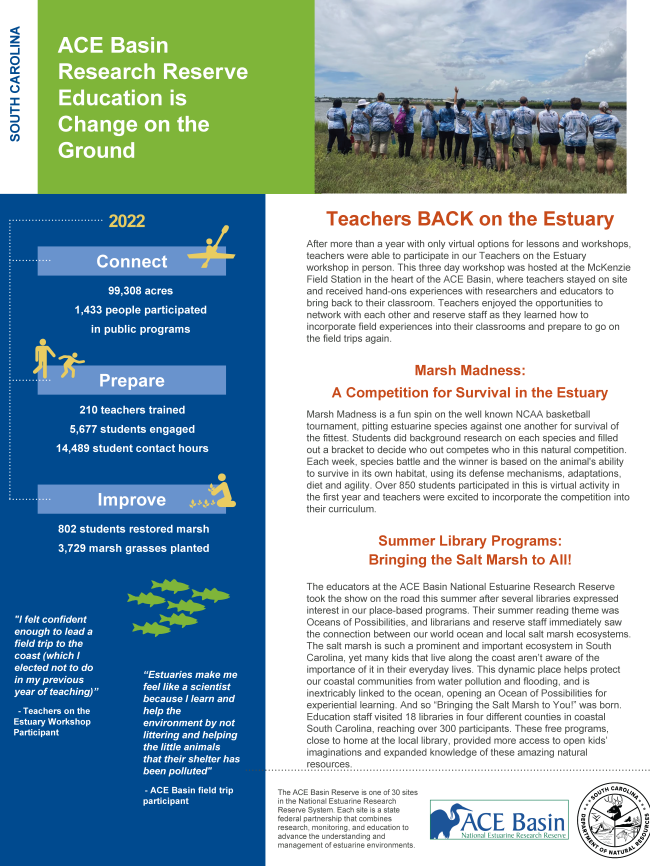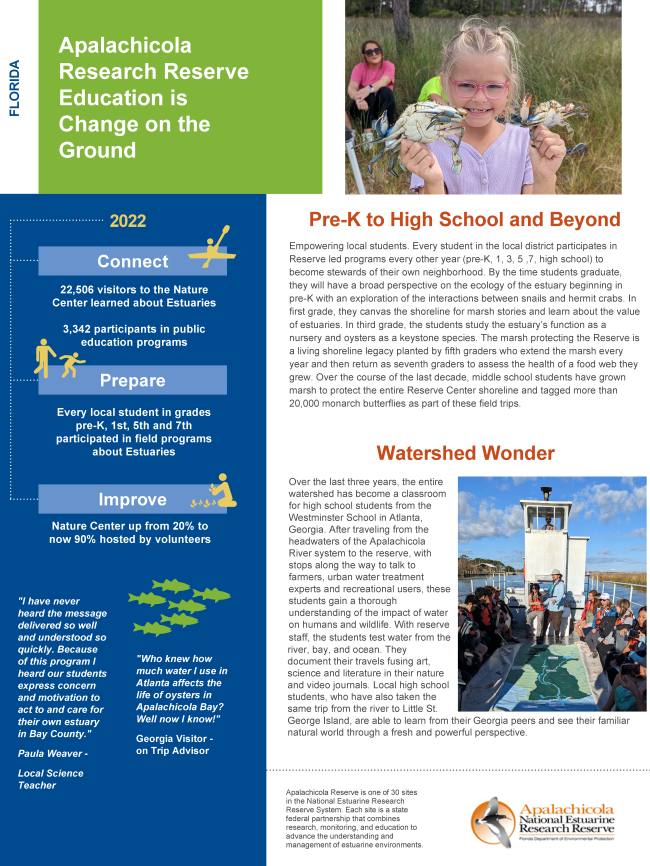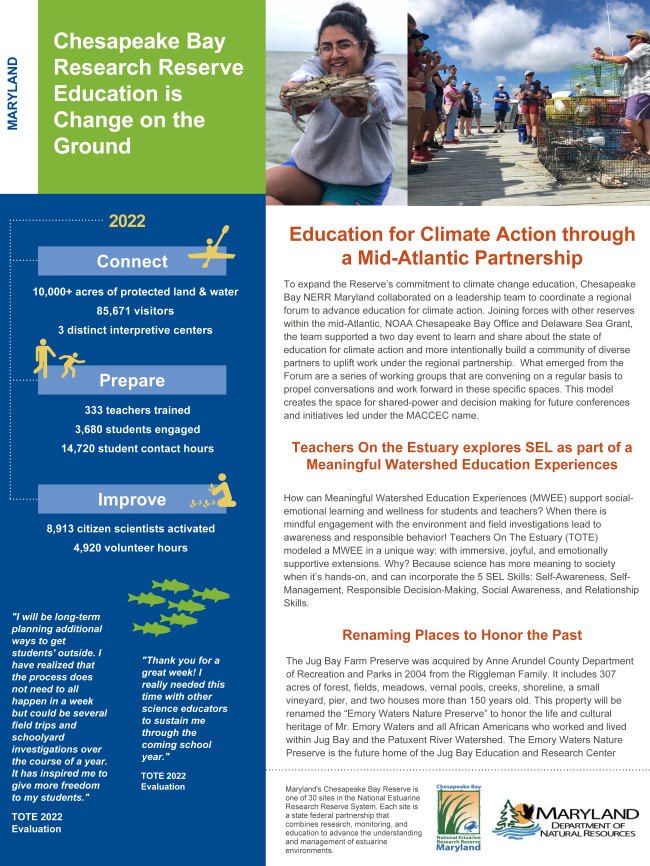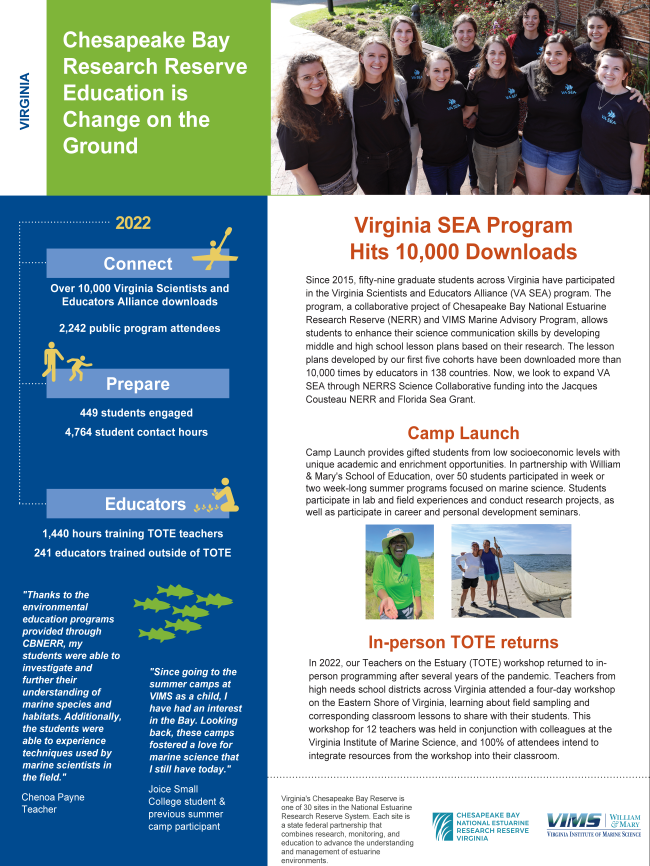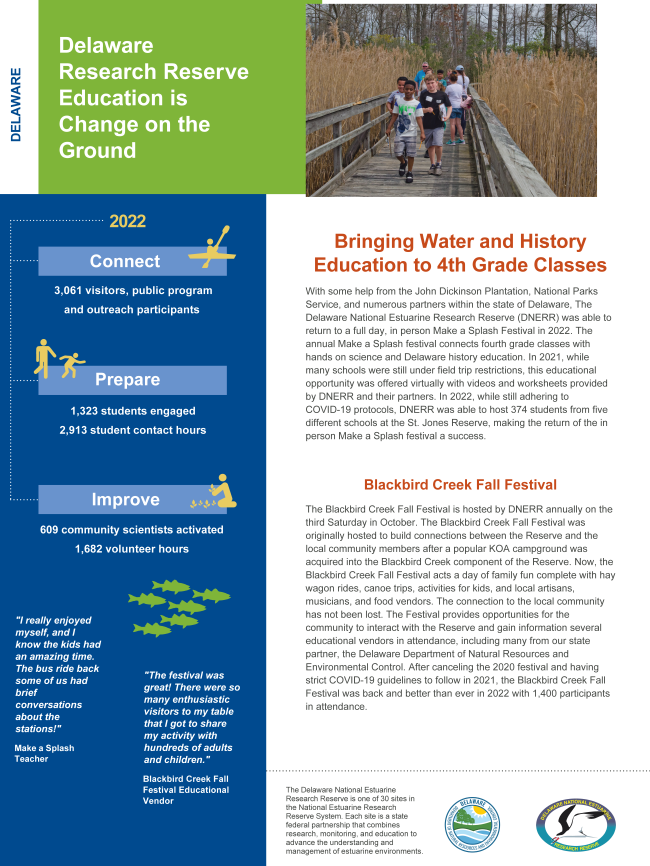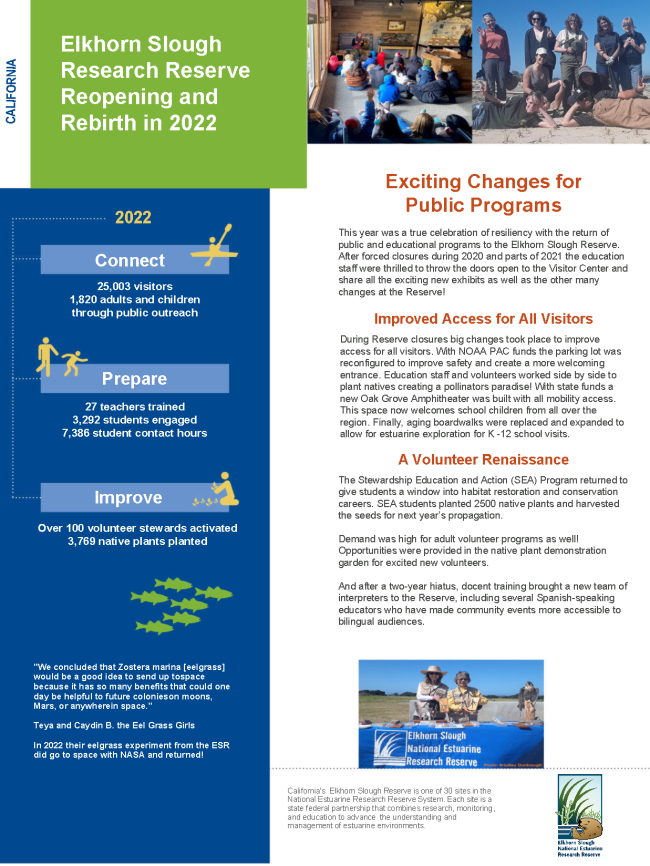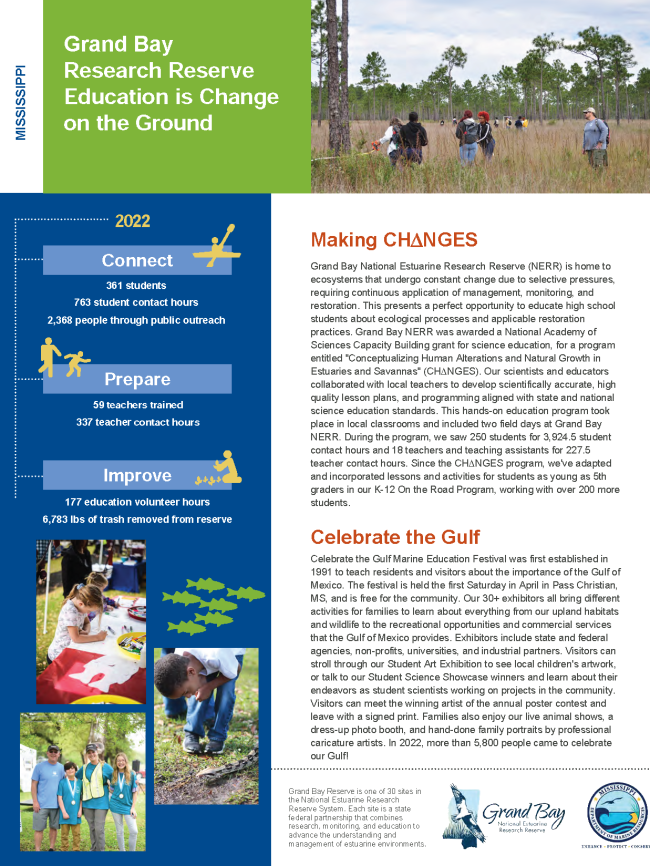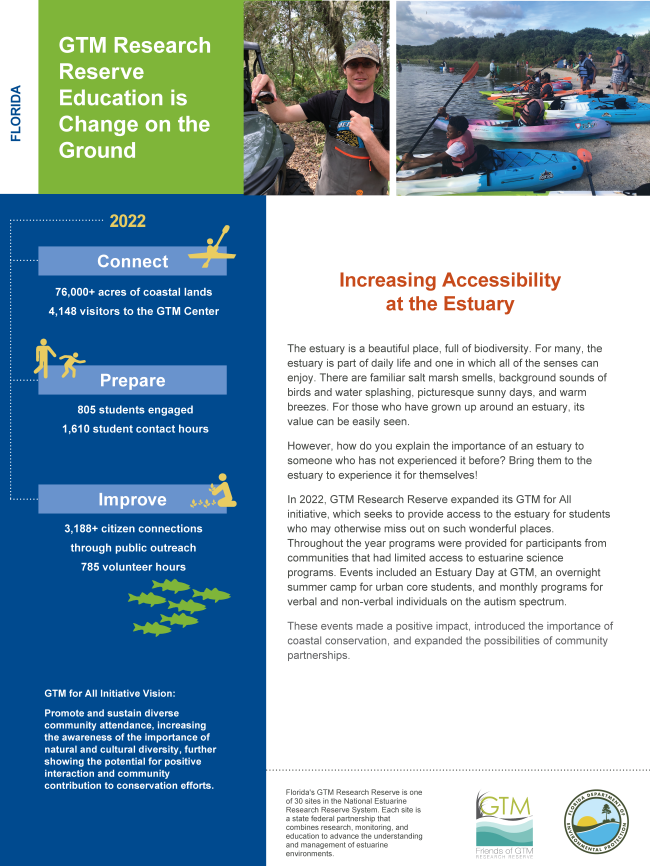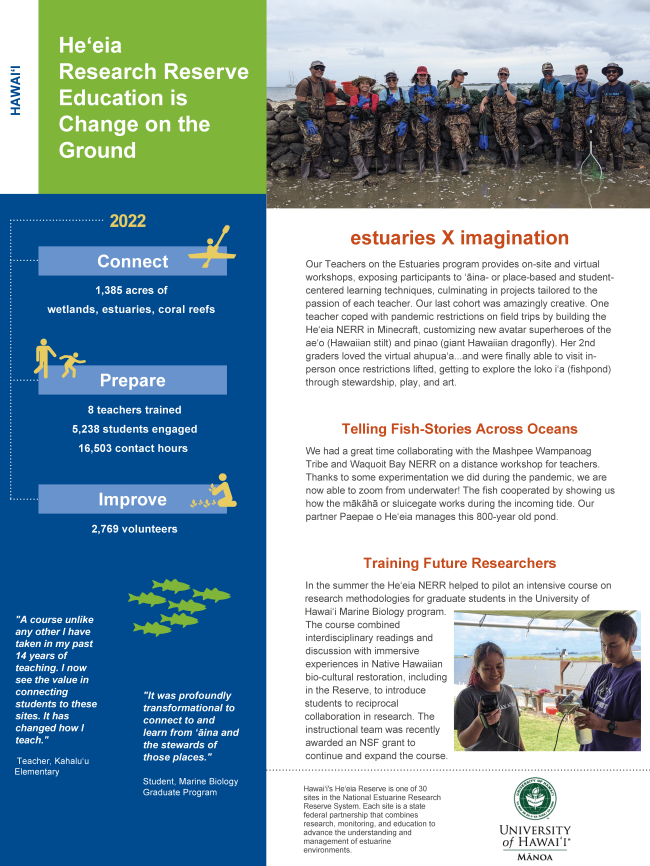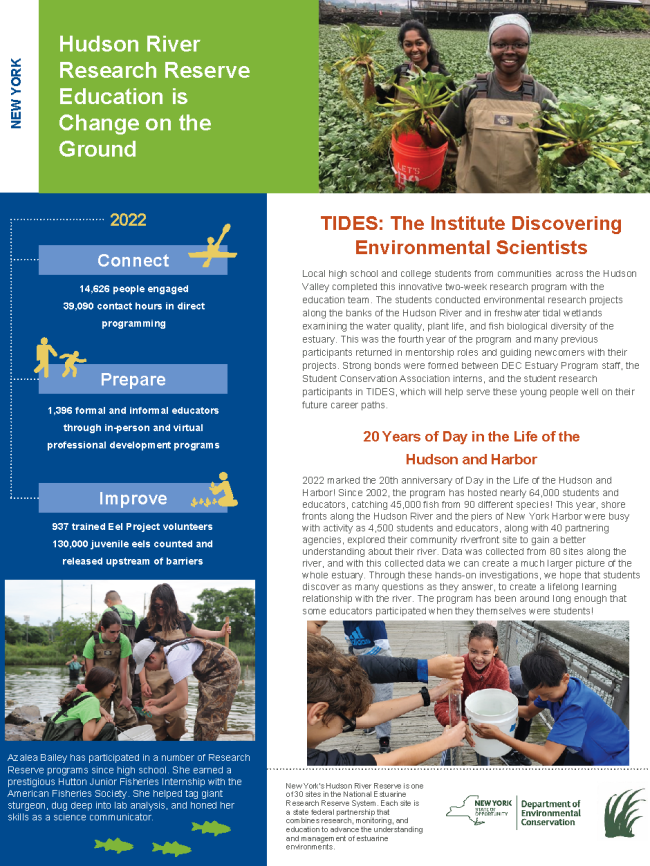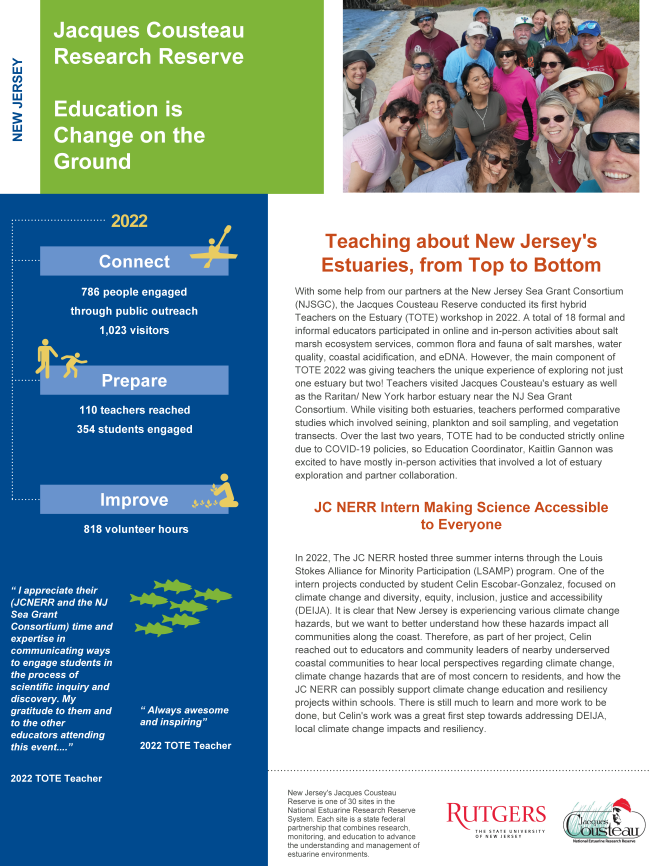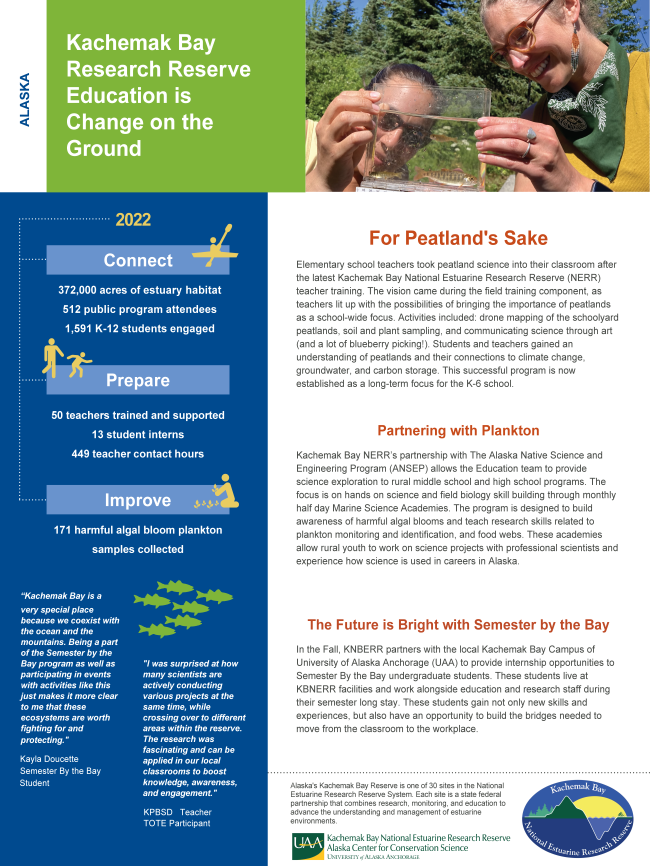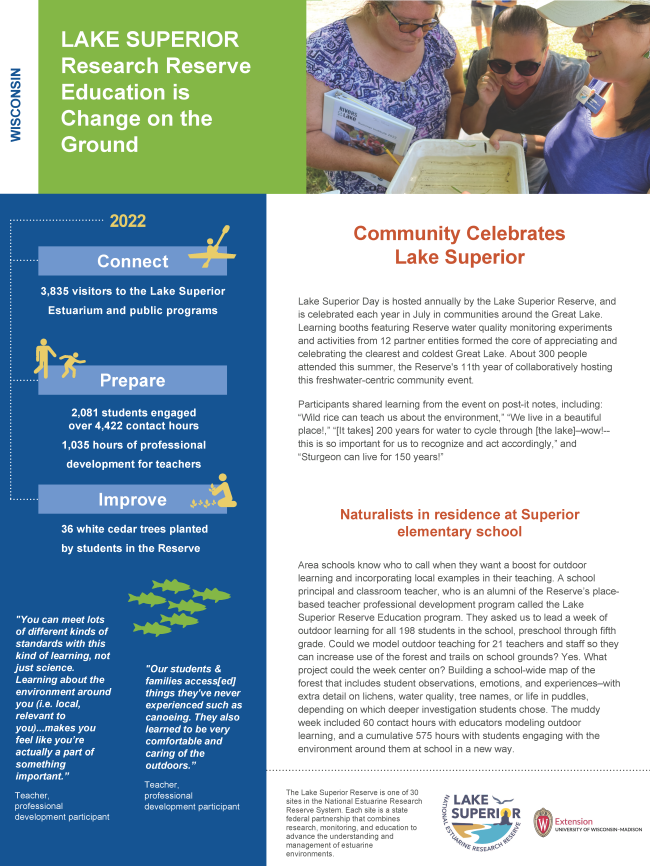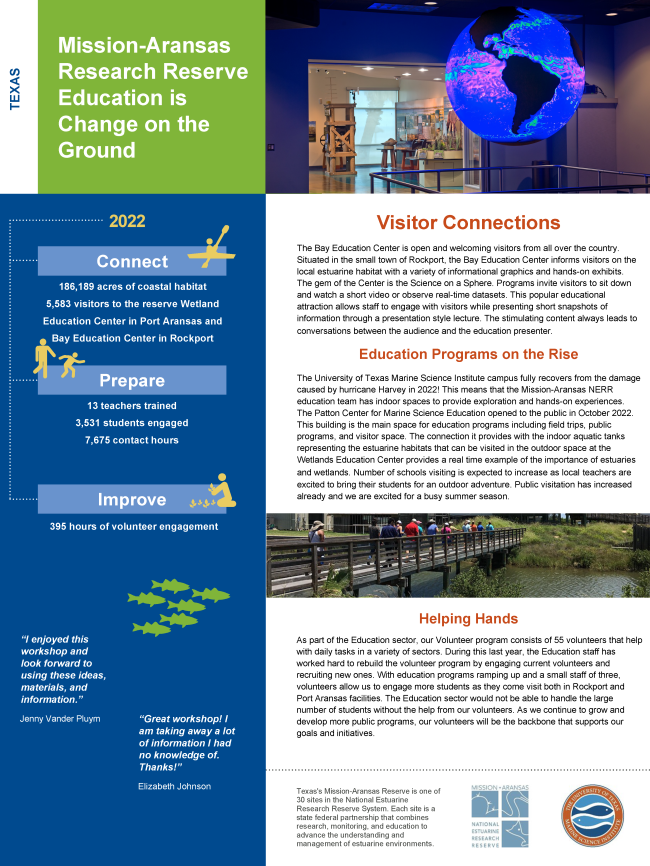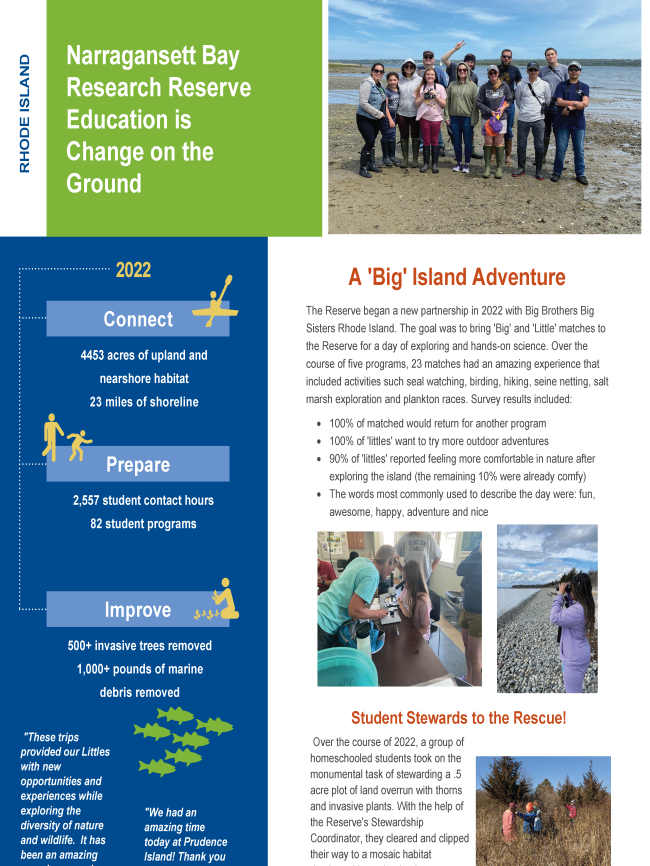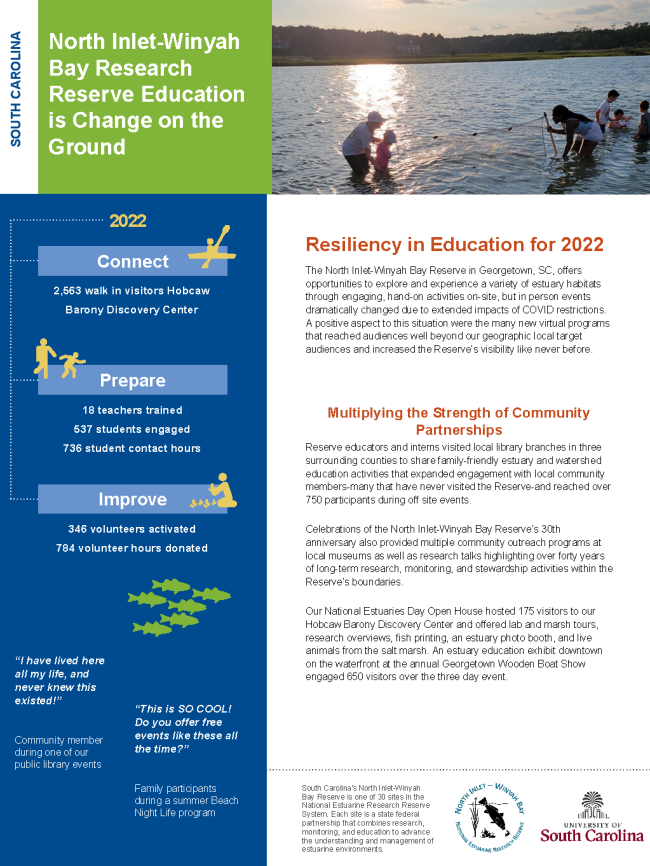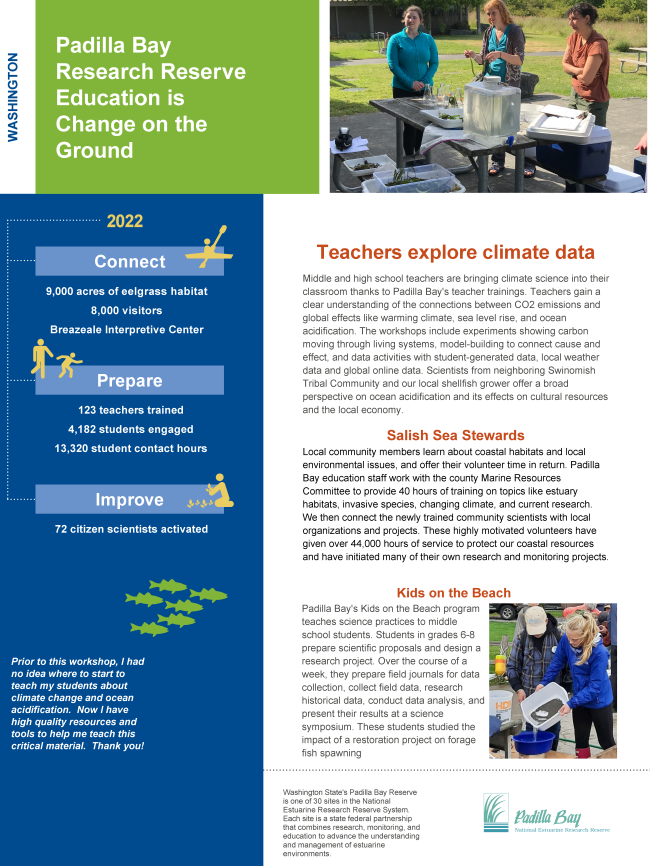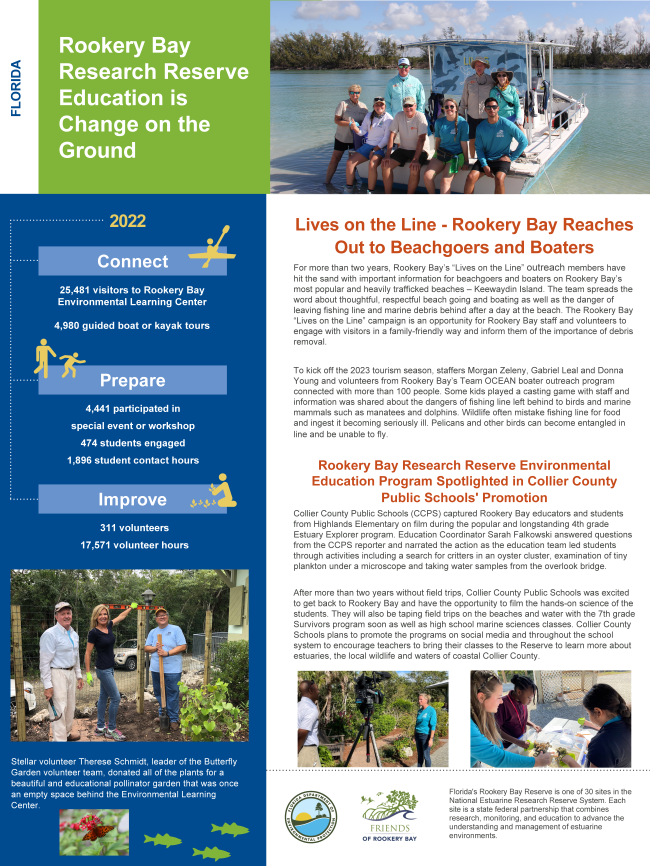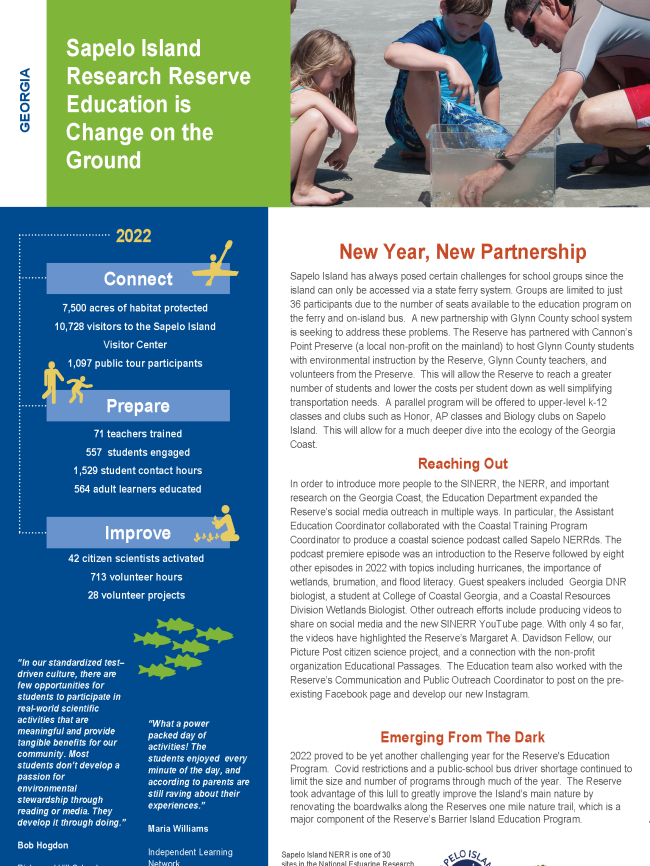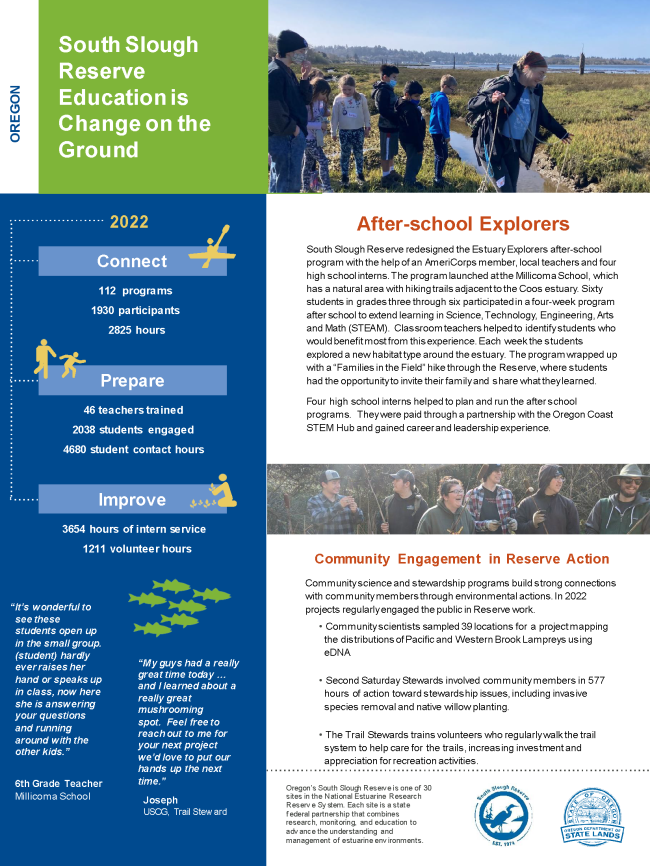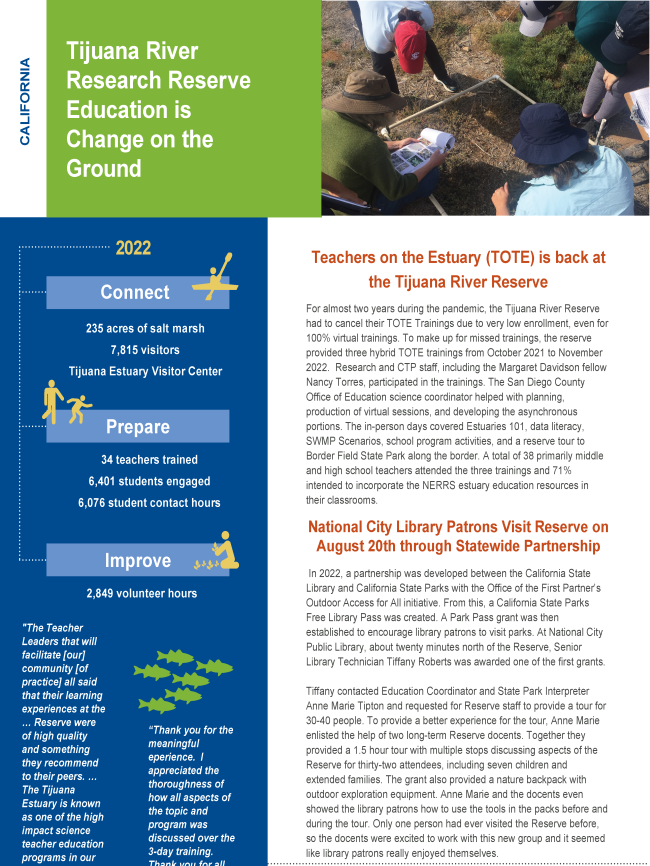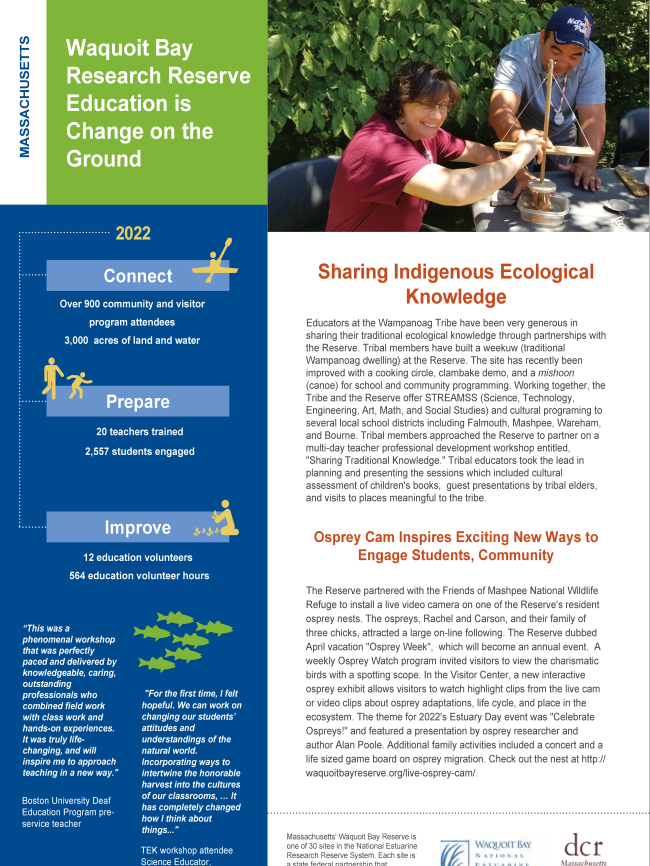The National Estuarine Research Reserve System is a network of 30 coastal sites designated to protect and study estuary systems and how they respond to human influence and environmental change. These sites are outdoor living classrooms that help build knowledge of the critical role estuaries play in our lives — from providing recreational opportunities to protecting our coastal communities. Explore the impact of these special places through this series of infographics.
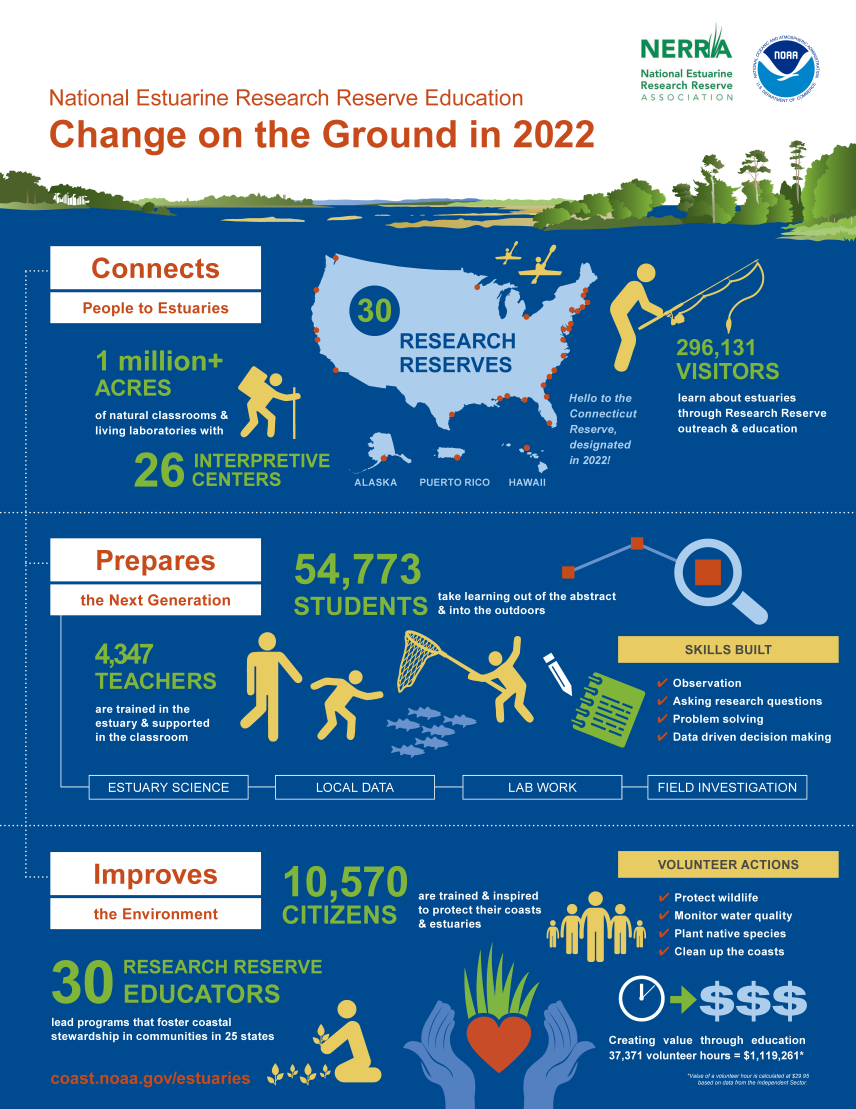
Download PDF
Infographic transcript
National Estuarine Research Reserve Education: Change on the Ground in 2022
Connects people to estuaries
- 1 million acres+ of natural classrooms and living laboratories with 26 interpretive centers.
- 30 research reserves located in the continental United States, Alaska, Puerto Rico, and Hawaii. Hello to the Connecticut Reserve, designated in 2022!
- 296,131 visitors learn about estuarine through Research Reserve outreach and education.
Prepares the next generation
- Provides opportunities for: estuary science, local data, lab work, and field investigation.
- 4,347 teachers are trained in the estuary and supported in the classroom.
- 54,773 students take learning out of the abstract and into the outdoors.
- Skills built: Observation, asking research questions, problem solving, data-driven decision making.
Improves the environment
- Improves the environment
- 30 Research Reserve educators lead programs that foster coastal stewardship in communities in 25 states.
- 10,570 citizens are trained and inspired to protect their coasts and estuaries.
- Volunteer actions: Protect wildlife, monitor water quality, plant native species, clean up the coasts.
- Creating value through education. 37,371 volunteer hours = $1,119,261 (Value of a volunteer hour is calculated at $29.95 based on data from the Independent Sector).
Preparing the next generation
Educating teachers and students on the value of estuary ecosystems helps safeguard these resources for future generations. The popular Teachers on the Estuary program provides field-based training to improve teachers’ understanding of the environment using local research. Subsequently, teachers bring this newfound knowledge to their students and colleagues, often inspiring positive environmental change. Through these activities, students and teachers build their knowledge of estuary science through local data, lab work, and field investigation.
Improving the environment
Research Reserve educators lead programs that engage citizens and foster coastal stewardship. Through these programs, reserve staff trained 10,570 citizens in 2022 inspiring them to protect their coasts and estuaries. Reserves rely on citizens to become volunteers who take ownership in protecting wildlife, monitoring water quality, planting native species, and cleaning up the coasts. Volunteer contributions are an integral piece of the daily operations within the reserves.
Explore how reserve education is creating change on the ground around the country and in your state. Find estuary educational resources and learn more about all sites at https://coast.noaa.gov/estuaries/.
Infographics from around the National Estuarine Research Reserve System
ACE Basin
Teachers are back on the estuary! After more than a year with only virtual options for lessons and workshops, teachers were able to participate in ACE Basin's Teachers on the Estuary workshop in person.
Apalachicola Research Reserve empowers every student in the local district from pre-K to high school through participation in programs to become stewards of their own neighborhood.
To expand the reserve’s commitment to climate change education, Chesapeake Bay Maryland collaborated on a leadership team to coordinate a Mid-Atlantic regional forum to advance education for climate action.
The Virginia Scientists and Educators Alliance program allows students to enhance their science communication skills by developing middle and high school lesson plans based on their research.
The Delaware Research Reserve was able to return to a full-day, in-person Make a Splash Festival in 2022, which connects fourth grade classes with hands on science and Delaware history education.
This year was a true celebration of resiliency with the return of public and educational programs to the Elkhorn Slough Research Reserve. The staff were thrilled to throw the doors open to the visitor center and share all the new exhibits.
Grand Bay Research Reserve was awarded a National Academy of Sciences Capacity Building grant for science education, for a program entitled "Conceptualizing Human Alterations and Natural Growth in Estuaries and Savannas" (CH∆NGES).
In 2022, Guana Tolomato Matanzas (GTM) Research Reserve expanded its GTM for All initiative, which seeks to provide access to the estuary for students who may otherwise miss out on such wonderful places.
Heʻeia's Teachers on the Estuaries program provides on-site and virtual workshops, exposing participants to ʻāina (place-based) student-centered learning techniques, culminating in projects tailored to the passion of each teacher.
The Institute Discovering Environmental Scientists (TIDES) program has local high school and college students from communities across the Hudson Valley complete this innovative two-week research program with the reserve education team.
The Jacques Cousteau Research Reserve conducted its first hybrid Teachers on the Estuary workshop in 2022 with formal and informal educators who participated in online and in-person activities.
Elementary school teachers took peatland science into their classroom after the latest Kachemak Bay Research Reserve teacher training.
Lake Superior Research Reserve hosts the annual Lake Superior Day celebrated by communities around the Great Lake. Learning booths feature water quality monitoring experiments and activities from twelve partner entities.
The Bay Education Center, situated in the small town of Rockport, informs visitors from across the country on the local estuarine habitat with a variety of informational graphics and hands-on exhibits.
The Narragansett Bay Research Reserve began a new partnership in 2022 with Big Brothers Big Sisters Rhode Island. The goal was to bring "Big" and "Little" matches to the reserve for a day of exploring and hands-on science.
The North Carolina Research Reserve serves as the perfect spot for students to learn about estuaries and their importance. Each year, hundreds of students come for a hands-on experience they will never forget.
The North Inlet-Winyah Bay Research Reserve offers opportunities to explore and experience a variety of estuary habitats through engaging, hand-on activities on-site. New virtual programs now reach audiences beyond our geographic location.
Old Woman Creek Research Reserve hosted high school seniors for a wetland studies program to learn and practice fish survey techniques, add to the reserve’s fish database, and use their fish observations to discuss the estuary food chain.
Middle and high school teachers are bringing climate science into their classroom thanks to Padilla Bay's teacher trainings. Teachers gain a clear understanding of the connections between CO2 emissions and global effects.
The Rookery Bay “Lives on the Line” campaign is an opportunity for Rookery Bay staff and volunteers to engage with visitors in a family-friendly way and inform them of the importance of debris removal.
Sapelo Island has always posed certain challenges for school groups since the island can only be accessed via a state ferry system. A new partnership with Glynn County school system is seeking to address these problems.
South Slough Research Reserve redesigned the Estuary Explorers afterschool program with the help of an AmeriCorps member, local teachers, and four high school interns. The program launched at a school adjacent to the Coos estuary.
After cancelling Teachers on the Estuary workshops during the pandemic, the Tijuana River Research Reserve made up for the lost time by providing three hybrid workshops from October 2021 to November 2022.
To share traditional ecological knowledge, the Wampanoag Tribe and the Waquoit Bay Research Reserve worked together to offer science, technology, engineering, art, math, social studies, and cultural programming to several local schools.
The Wells Research Reserve's Interpretive Guide Trainers facilitated workshops, which covered interpretive concepts and guided participants in fostering heartfelt connection between visitors and the site's natural and cultural resources.


